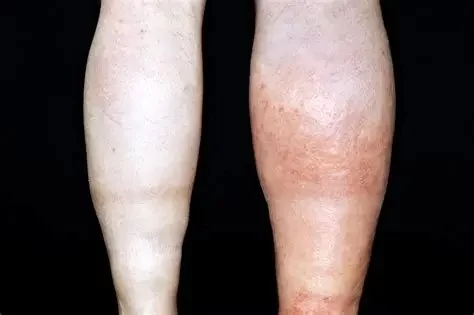- What is Deep Vein Thrombosis (DVT)?
- What Causes Deep Vein Thrombosis?
- Symptoms of Deep Vein Thrombosis
- How to Prevent Deep Vein Thrombosis
- Treatment Options for Deep Vein Thrombosis
- Case Study: A Real-Life DVT Experience
1. What is Deep Vein Thrombosis (DVT)?
Deep Vein Thrombosis (DVT) is a condition where a blood clot forms in a deep vein, typically in the legs. While often asymptomatic, it can be extremely dangerous if the clot travels to the lungs, causing a pulmonary embolism. DVT is commonly linked to prolonged periods of immobility, certain medical conditions, or lifestyle factors like smoking and being overweight.
Blood clots are not always harmful when they form in response to injury; however, DVT clots occur inside veins without an obvious cause. If left untreated, these clots can block blood flow or break loose and cause life-threatening complications.

2. What Causes Deep Vein Thrombosis?
The causes of DVT are multifactorial, but a few common risk factors include:
- Prolonged immobility: Extended periods of sitting or lying down, such as during long flights or bed rest, increase the risk of developing blood clots.
- Injury to veins: Surgery or physical trauma can damage blood vessels, making it easier for blood clots to form.
- Medical conditions: Certain health conditions, including cancer, heart disease, and obesity, can increase the risk of DVT. These conditions may affect blood flow or clotting factors.
- Pregnancy and childbirth: Pregnancy increases pressure on the veins in the pelvis and legs, raising the likelihood of DVT, especially after giving birth.
- Age and family history: Older adults are more likely to develop DVT, and a family history of the condition can also increase risk.
In many cases, multiple factors contribute to the development of DVT, making it a complex condition to manage.
Sandeep Gupta, MD
gupta sandeep md
1000 Asylum Ave Suite 3201 A, Hartford, CT 06105, USA

3. Symptoms of Deep Vein Thrombosis
Recognizing the symptoms of DVT early can be critical in preventing serious complications. Some common symptoms include:
- Swelling: This often occurs in one leg, but it can affect both.
- Pain or tenderness: You might feel pain in the affected area, especially when standing or walking.
- Red or discolored skin: The skin over the clot may appear red or feel warm to the touch.
- Swollen veins: The veins in the affected area might become more visible and engorged.
In some cases, DVT can be asymptomatic, which makes it especially dangerous because it may go unnoticed until it causes complications like a pulmonary embolism.
4. How to Prevent Deep Vein Thrombosis
Preventing DVT involves reducing the risk factors and promoting healthy circulation. Here are some practical steps to help prevent the condition:
- Stay active: Regular physical activity, such as walking or cycling, helps to improve blood circulation and reduces the risk of clots forming.
- Avoid prolonged immobility: If you're on a long flight or car trip, make sure to get up and move around at regular intervals to keep your blood circulating.
- Wear compression stockings: These stockings can help reduce swelling and improve circulation, especially for people at higher risk of DVT.
- Maintain a healthy weight: Excess weight puts added pressure on veins and increases the likelihood of developing DVT. Eating a balanced diet and exercising regularly can help manage weight.
- Manage underlying health conditions: Conditions such as heart disease or diabetes can increase the risk of DVT, so it’s important to manage them with the help of your healthcare provider.
If you are at high risk for DVT, it's essential to talk to your doctor about the best prevention strategies, such as blood thinners or other medications.
5. Treatment Options for Deep Vein Thrombosis
Treatment for DVT focuses on preventing the clot from growing, breaking free, or causing a pulmonary embolism. Common treatment options include:
- Anticoagulants (blood thinners): These medications, such as warfarin or newer drugs like rivaroxaban, help to prevent blood clots from becoming larger and reduce the risk of new clots forming.
- Thrombolytics: In severe cases, clot-dissolving medications may be used to break down the clot.
- Compression stockings: These may be recommended to reduce swelling and prevent complications from DVT.
- Filter devices: In some cases, a filter may be inserted into a vein to catch clots and prevent them from reaching the lungs.
For some individuals, surgery may be necessary to remove the clot if it poses a significant risk to health.
6. Case Study: A Real-Life DVT Experience
Let's look at a real-life example. Jane, a 45-year-old woman, had recently undergone knee surgery. She was immobile for several weeks during her recovery, and soon after, she noticed swelling and pain in her left calf. After a visit to her doctor, she was diagnosed with DVT. Jane’s doctor prescribed anticoagulants and recommended wearing compression stockings. Fortunately, the condition was detected early, and with treatment, Jane fully recovered without any long-term complications.
This case underscores the importance of monitoring your health post-surgery and staying proactive in managing risks like DVT.






















Sandeep Singh, MD
dr sandeep singh
341 Central Park Ave, Scarsdale, NY 10583, USA